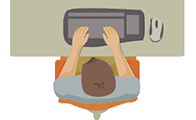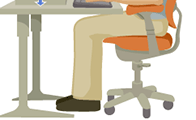Ergonomics
Ergonomics
The term “ERGONOMICS” is derived from two Greek words: “ERGON” meaning work and “NOMOI” meaning natural laws. Ergonomists study human capabilities in relationship to work demands.
Need for Ergonomics
Ergonomics may seem like a somewhat confusing and far-reaching term but the essence of the concept is rooted in simplicity. The field simply focuses on relieving people of any form of emotional and physical stress and making people more comfortable whether they are at home or work. It also helps people achieve a better level of harmony and peace as well and reduces the propensity for people to get injured or sick in the workplace. Ergonomics isn’t simply about buying furniture to reduce the amount of stress or strain your body is subjected to on a daily basis. Ergonomics also focuses on the reduction of discomfort and the alleviation of stress on different areas of the body. These areas are the physical areas (hands, neck, back, eyes) and the mental areas as well. All of this in turn helps boost your response to life issues and your productivity as well as your immune system.
Key things not to do
- Remember that ergonomics is personal. What works for someone else may not work for you.
- Do not settle for a desk without a keyboard tray or some other way to set the keyboard height and angle correctly. If your employer complains about the cost ask them to compare it to the cost of workman’s compensation.
- Do not place the keyboard on top of the desk.
- Do not place the monitor above your head.
- Do not sit in a rigid and upright position.
- Do not lean forward.
- Do not work for long periods of time without moving. You need to take frequent breaks.
Ergonomics Guidelines
Monitor

- Position the monitor to minimize glare by placing it at a right angle to light sources or windows
- Place the monitor as far away from you as possible while maintaining the ability to read without consciously focusing. Keep a minimum distance of 20 inches.
- Place the center of the screen at a 15 degree down angle from your eyes with your neck only slightly bent holding your head perpendicular to the floor.
- Align the monitor and the keyboard / mouse
- Set the refresh rate at a minimum of 70 Hz to limit flicker
Lighting
- The office should be moderately bright (20-50 foot candles or equal to a nice day where sunglasses aren’t needed).
- Do not use task lighting for computer work.
- A mix of incandescent and fluorescent lights reduces flicker and provides good light color.
Keyboard

- Position the keyboard slightly below the elbow and at a negative angle to allow the wrists to remain straight when you sit in a slightly reclined posture
- Do NOT use a wrist rest while actively typing. It’s meant to rest on not to lean on when working. Hold your hands and arms off of any supports while typing.
- Do NOT use the keyboard supports to raise the back up.
- Do NOT tilt the keyboard tray so that the back of the keyboard is higher than the front. Though design and a lot of prevailing information say you should tilt the keyboard to a positive angle like this, it is wrong.
Mouse & Forearms

- When typing, your wrists should be in line with your forearms and not bent up, down, or to the side.
- Your keyboard should be directly centered in front of you. Other frequently used items should be nearby, within arm’s reach.
- Place the mouse on the same level as and immediately next to the keyboard tray.
- Keep the mouse in the arc line of the keyboard so that you can reach it when rotating your arm from the elbow.
- Do NOT use a wrist rest while using the mouse. Your forearm needs to be free to move so you do not strain the wrist.
Feet
- Your feet should be flat on the floor with your knees at a ~90 degree angle.
- Your seat should not be pressing into the back of your knees; if necessary, tilt it slightly forward to alleviate any knee pressure. Sit fully back in your chair, with your back and shoulders straight and supported by the back of the chair.
Suggested posture of sitting
- Shoulder Relaxed
- Elbow at 90 Degree
- Back Support
- Knee 90-120 Degree
- Foot Comfortable on Ground